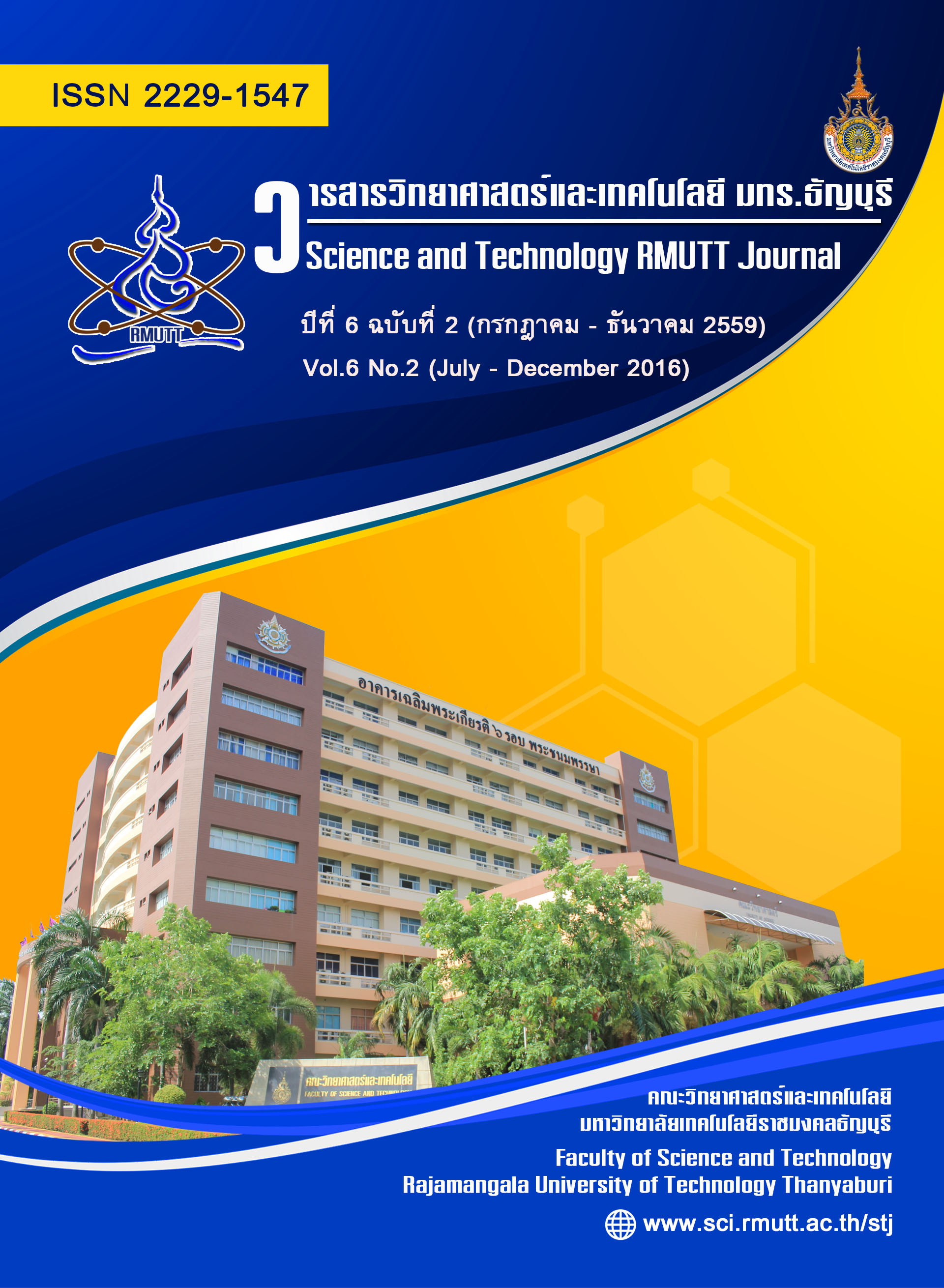Suitable cell age for enhanced poly-ß-hydroxybutyrate accumulation under photoautotrophic nutrient deprivation of Synechocystis sp. PCC 6803
Main Article Content
Abstract
Synechocystis sp. PCC 6803 can convert atmospheric CO2 and water into carbohydrates by photosynthesis and store them as glycogen, lipid or poly-ß-hydroxybutyrate (PHB) when nutrient limitation. In this study, under normal photoautotrophic condition, Synechocystis cells could utilize nitrate and phosphate in medium for supporting growth, but cells did not show high PHB accumulation (0.1 – 6.5 %(w/w) DW) in all cultivated times although the concentration of nitrate and phosphate were low levels. The age of cell was found to have a major effect on PHB accumulation in Synechocystis cell. The maximum PHB content was 15.2 % (w/w) DW when cells at mid-stationary phase adapted in photoautotrophic nutrients (nitrogen and phosphorus) deprivation for 8 days. However, cells in all stationary phase were also found to accumulate of glycogen at higher levels than PHB. Therefore the main carbon storage component under photoautotrophic nutrient deprivation might be glycogen and PHB as a co-component, respectively.
Article Details
References
Steinbiichel A., Füchtenbusch B., Gorenflo V., Hein S., Jossek R., Langenbach S. and Rehni B.H.A. Biosynthesis of polyesters in bacteria and recombinant organisms. Polym Degradation Stab. 1998. 59: 177-182.
Valappil S.P., Misra S.K., Boccaccini A.R., Keshavarz T., Bucke C. and Roy I. Large-scale production and efficient recovery of PHB with desirable material properties, from the newly characterised Bacillus cereus SPV. J Biotechnol. 2007. 132: 251-258.
Anderson A.J. and Dawes E.A. Occurrence, metabolism, metabolic role and industrial uses of bacterial polyhydroxyalkanoates. Microbiol Rev. 1990. 54: 450-472.
Panda B. and Mallick N. Enhanced poly-beta- hydroxybutyrate accumulation in a unicellular cyanobacterium, Synechocystis sp. PCC 6803. Lett Appl Microbiol. 2007. 44: 194–198.
Kaneko T. Sequence analysis of the genome of the unicellular cyanobacterium Synechocystis sp. strain PCC 6803. II. Sequence determination of the entire genome and assignment of potential protein-coding regions. DNA Research. 1996. 3: 109-36.
Wu G., Bao T., Shen Z., and Wu Q.. Sodium acetate stimulates PHB biosynthesis in Synechocystis sp. PCC 6803. Tsinghua Sci. Technol. 2002. 7: 435–438.
Panda B., Jain P., Sharma L. and Mallick N. Optimization of cultural and nutritional conditions for accumulation of poly-beta-hydroxybutyrate in Synechocystis sp. PCC 6803. Bioresour Technol 2006. 97: 1296–1301.
Monshupanee, T. and Incharoensakdi, A. Enhanced accumulation of glycogen, lipids and poly hydroxybutyrate under optimal nutrients and light intensities in the cyanobacterium Synechocystis sp. PCC 6803. J Appl Microbiol. 2014.116: 830–838.
Rippka R., Deruelles J., Waterbury J.B., Herdman M. and Stanier R.Y. Generic assignments, strain histories and properties of pure cultures of cyanobacteria. J Gen Microbiol. 1979. 111: 1–61.
MacKinney G. Absorption of light by chlorophyll solutions. J Biol Chem. 1941.140: 315–322.
APHA, AWWA, WEF. Standard Methods for the Examination of Water and Wastewater. 20th ed. American Public Health Association, Washington, D.C, 1998.
Khetkorn W., Incharoensakdia A., Lindblad P. and Jantaro S. Enhancement of poly-3-hydroxybutyrate production in Synechocystis sp. PCC 6803 by overexpression of its native biosynthetic genes. Bioresource Technol. 2016. 214 : 761-768.
Bandyopadhyay A., Stockel J., Min H., Sherman LA.and Pakrasi H. High rates of photobiological H2 production by cyanobacterium under aerobic condition. Nature Commum. 2010. 1: 139.
Yoo S.H., Keppel C., Spalding M. and Jane J.L. Effects of growth condition on the structure of glycogen produced in cyanobacterium Synechocystis sp PCC6803. Int J Biol Macromol. 2007. 40: 498–504.
Grossman R., Schaefer M., Chiang G. and Collier J. The responses of cyanobacteria to environmental conditions: light and nutrients. In: Bryant D.A., editor. The Molecular Biology of Cyanobacteria. Springer, Netherlands. 2004: 641–675.
Aikawa S., Izumi Y., Matsuda F., Hasunuma T., Chang J.S. and Kondo A. Synergistic enhancement of glycogen production in Arthrospira platensis by optimization of light intensity and nitrate supply. Bioresour Technol. 2012. 108: 211–215.


